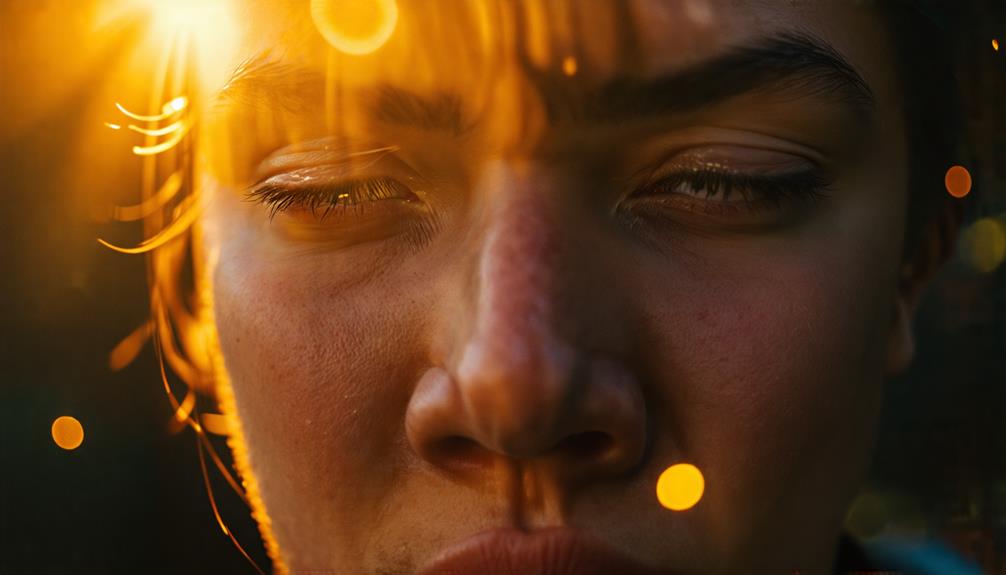You've probably experienced it yourself or witnessed someone else do it: a sudden sneeze triggered by bright light. This peculiar phenomenon, known as photic sneezing or ACHOO syndrome, affects around 25% of the population. It's not just a quirky coincidence; there's actual science behind this reflex. As you step into sunlight or encounter a sudden flash, your body might react in ways you'd never expect. But what causes this unusual response, and why does it only happen to some people? The answers lie in the intricate connections within your nervous system and your genetic makeup.
Key Takeaways
- Photic sneezing affects approximately 25% of the population, aligning with the "one in four" statistic.
- The condition is known as ACHOO syndrome, triggering involuntary sneezes when exposed to bright light.
- Photic sneezing is caused by a neurological crossover between optic and trigeminal nerves.
- The reflex is characterized by sneezing within seconds of light exposure, often preceded by a nose tingling sensation.
The Science Behind Photic Sneezing

Photic sneezing, affecting about a quarter of the population, occurs when bright light triggers an involuntary sneeze due to a unique neurological crossover. This phenomenon, also known as ACHOO syndrome, is characterized by a sudden sneeze reflex within seconds of exposure to bright light, often following a shift from darkness. You might experience a prickling sensation in your nose before the sneeze.
The science behind photic sneezing involves a connection between your optic nerve and trigeminal nerve. This crossover causes your brain to misinterpret light signals as nasal irritation, leading to an involuntary sneeze.
It's an autosomal dominant trait, meaning if you have it, there's a 50% chance you'll pass it to your children. Genetic predisposition plays a significant role, with the reflex being more common in people with light-colored eyes, particularly white males and females.
Prevalence and Genetic Factors
Roughly one in four people experience the peculiar phenomenon of sneezing when exposed to bright light, a trait that's largely determined by genetics. This condition, known as the photic sneeze reflex or ACHOO syndrome, affects about 18-35% of the population. It's considered a dominant trait, meaning if you have it, there's a 50% chance you'll pass it on to your children.
The prevalence of this reflex is higher among those of European descent, particularly individuals with light-colored eyes. Notably, it's more common in white males than females.
You might inherit this tendency without even realizing it, as it often begins in childhood or adolescence. Some people only sneeze when shifting from dark to bright environments, like emerging from a tunnel into sudden exposure to sunlight.
Genetic factors play a significant role in determining who experiences this unique response to light.
Managing Light-Induced Sneezes

While genetics largely determine who experiences light-induced sneezes, there are several practical ways you can manage this quirky reflex in your daily life.
To reduce your exposure to bright light and minimize photic sneezing:
- Wear sunglasses or a hat when shifting from dark to light environments.
- Keep your nasal passages clear through regular hygiene.
- Use antihistamines if you have allergies, which may help decrease sneezing frequency.
- Communicate with healthcare providers about your condition for appropriate accommodations.
Awareness of the photic sneeze reflex is essential for safety, especially if you drive or operate machinery.
By taking these steps, you can better manage your light-induced sneezes and reduce their impact on your daily activities.
Conclusion
You're not alone if you find yourself sneezing when exposed to bright light. It's a common phenomenon affecting about 25% of people.
While you can't cure this genetic quirk, you can manage it by wearing sunglasses or shielding your eyes when moving to bright environments.
Remember, it's harmless and doesn't indicate any underlying health issues. Embrace your unique reflex, and don't let it dim your enjoyment of sunny days!

Leave a Reply